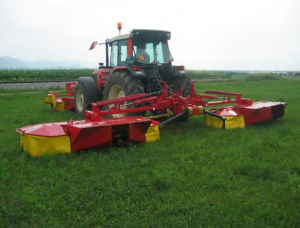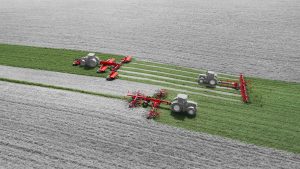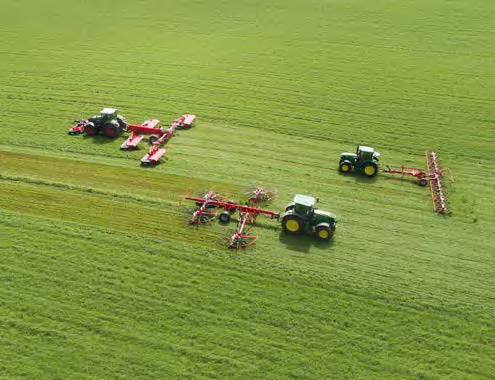Known world wide for their grass harvesting machines, SIP is a Slovenian manufacturer of agricultural machinery with a long tradition, exporting its products to over 45 countries with France, Austria, Switzerland, Germany and Italy at the helm.
Farmers of Europe had a chat with Marketing Director Mihael Miheljak from the SIP headquarters in Šempeter, Slovenia.
 SIP has big ambitions, as Mihael tells us from the start: to become a leading specialist in mowing and grassland harvesting systems. The company specialises in three segments: lightweight solutions for specialized alpine and mountaineer farmers, a more robust line for medium-sized farms and contractors and heavy-duty systems for large-scale farming projects.
SIP has big ambitions, as Mihael tells us from the start: to become a leading specialist in mowing and grassland harvesting systems. The company specialises in three segments: lightweight solutions for specialized alpine and mountaineer farmers, a more robust line for medium-sized farms and contractors and heavy-duty systems for large-scale farming projects.
The company’s history, however, started in 1954 with the creation of “Agroservis”, a workshop for maintenance and services for agricultural machinery.
History
Foundation
“In its first decade, the company operated as workshop for, among others, Steyer, Zetor, JO-BU and Carlo Pesci products”, Mihael explains. “The workshop also produced various industrial machines, but the production of machinery for agriculture only started around 1960.”
The name “SIP” was introduced in 1967 and replaced “Agroservis”. Gradually, the company abandoned the production of industrial machinery to focus on the serial production of agricultural machines from 1969.
In 1971, the company reached a first milestone in a long line of milestones to come, with the production of the first loading wagon, SIP’s most representative product from the seventies. Many of the wagons produced in that era are still used today. Soon, the company had to expand and a first new, 8400m2 production hall was built two years later for the then 300 employees. SIP’s first branded products were introduced.
SIP in the eighties
 The period from 1978 tot 1987 was one of exportation, the establishment of production range and a boom in people employed by the company. These years, after the launch of the first rotary rake in 1979, were also years of prototypes.
The period from 1978 tot 1987 was one of exportation, the establishment of production range and a boom in people employed by the company. These years, after the launch of the first rotary rake in 1979, were also years of prototypes.
“It was a booming period for SIP, with numerous investments (in development), new machines being launched and the purchase of licenses. SIP patented the first side delivery double rotary rake on the market in 1982, and the first mower with conditioner five years later! Its number of employees never went under 1000, peaking at 1356 in 1985, making it one of the most prominent European manufacturers of agricultural machinery.”
Rebranding, start of exhibition participations and export
SIP underwent a first rebranding in 1992, trying to introduce green colouring for its products. The red being so characteristic for the brand, however, it quickly returned to its original colours. By 1994, the production extended to double axle tractor mowers. Meanwhile, SIP discovered agricultural fairs such as EIMA and Agritechnica and started its tradition of participating in them.
The nineties were also an era of expansion for the company, with the first exports to the United States and Australia by 1995. With a presence in 26 countries through over 50 dealers, SIP was now known all over the world.
Spider, Big Roto and Big Laser
With the end of the nineties and the early 00’s, SIP introduced various innovations, such as 8-metre working width technology and a tandem axle, patented for both one and two rotor rakes.
In 1999, a new Eisenmann painting line and sheet metal laser cutting machine were added to the production hall, making the production of three innovations possible over the following years.
“The modular rotor for rotary rakes was first released in 2004”, Mihael continues, “after the 6 rotor rotary shredder Spider 800 for 8 meter working width and the first triple mower combination Big Roto, both released in 2000. Big Roto was replaced by the improved disc mower combination Big Laser, equipped with hydro-pneumatic suspension, in 2004.”
SIP today
In 2009, SIP launched the Silvercut Disc 900 C FC, the first 9 meter finger conditioner combination on the market, equipped with a hydro-pneumatic suspension system and disc drive safety system before rebranding four years later.
“During this rebranding, the brand underwent a visual transformation meant to embody SIP’s core values: durability, efficiency and usefulness”. The old logo, representing Europa and Zeus in bull-shape – based on a relief from a Roman tomb found in Šempeter – was completely restyled.
SIP also introduced 15 meter working width technology during this period, with the launch of Spider 1500|10 T, a 15 meter tedder equipped with the patented hydraulic adjustment of tedding angle system, in 2011. By 2015, the brand proposed a complete set of machines in a 10 meter working width, topping this by a set of machines in 15 meter working width by 2017.
“Our set of SIP Air pick-up rakes, also launched in 2017, are our future-oriented machines with cutting edge elastic pick-up technology.”
SIP’s export vision
 “Export represents 80% of turnover in SIP”, says Mihael. “It has been important from the very beginning for our company. Until 1991, exportation was mainly focused on the Balkans, Eastern Europe, Austria, Germany and China. After 1991, due to geopolitical conditions, we were forced to look for new customers around the world, and by 1995 we had also started transporting overseas, to America, North Africa and Australia.”
“Export represents 80% of turnover in SIP”, says Mihael. “It has been important from the very beginning for our company. Until 1991, exportation was mainly focused on the Balkans, Eastern Europe, Austria, Germany and China. After 1991, due to geopolitical conditions, we were forced to look for new customers around the world, and by 1995 we had also started transporting overseas, to America, North Africa and Australia.”
“From the very beginning, we have attended all the most important fairs in Europe: from Agritechnica – first in Frankfurt, then in Hanover – to FIMA in Zaragoza, Spain; EIMA (Bologna, Italy); the International Agricultural Fair of Novi Sad, Serbia) to Techagro in Brno, Czech Republic.”
SIP’s future ambitions and what’s to come for European agriculture
As Mihael remarks, the market for agricultural machines has developed significantly in recent years. An evolution that has not gone unnoticed at SIP: “we’ve experienced a transition of small farms from drum mowers towards disc mowers as the technology brings more added value for the customers: lower power consumption, cheaper maintenance, cleaner forage, better crop regeneration, etc. In general, farmers are transitioning towards more sustainable and cost efficient solutions. Trends in a segment of professional users are going in the direction of higher efficiency as well.”
Environment and climate significantly affected the market. As winters are getting warmer every year and summers dryer, the working period is becoming a lot longer than it was in the past: “in some northern hemisphere areas, contractors are mowing almost all year long now, even in December and January. This is because quantities of hay are lower in summer due to the dry weather, so there is a need to make hay – mainly wrapped bales – during winter to have enough for the cattle. As winters are getting warmer and warmer, the vegetation growth never stops so that farmers can grow good quality and quantity forage even during winter seasons”, he says, underlining that flexibility will be key for our sector.
“Contractors will have to offer flexible options for their customers to satisfy their needs on the one hand and not lose time and money on the other. To increase productivity and capacity with daily work rates, the market will demand more efficient machinery, widening working widths, and flexibility. Smart farming options allowing contractors and users to be more flexible and efficient will be in greater demand in the future. Electric solutions are not yet in demand with us, but with the development of efficient electric drive tractors, the market will have to adapt to the electrification and digitization of agricultural machinery.”
Text: Kim Schoukens – Images: SIP
This article appeared in Farmers of Europe 1-2021
Click here to read the magazine for free










